- Originally Published: February 28, 2019
- 8 Comments
- Jillian Smith, RD, Bianca Gruenewald, RD & Mallory Roberts, SLP
- Updated: March 10, 2025
Eggs are one of our FAVORITE foods for babies here at My Little Eater. They’re so nutritious, sustaining, and versatile, and are a great choice for breakfast, lunch, supper, or a quick snack when you’re in a pinch.
They really are the perfect package for a rapidly growing baby with many important nutrients including iron, protein, B vitamins, and antioxidants!
When it comes to how to make eggs for babies, there can be a lot to know, including how to safely serve them as a priority allergen. Eggs are also one of those foods that babies and toddlers may refuse to eat because of their unique texture, making it even more important to introduce them early and continue offering them in various forms.
Let’s go through all of the information you need to know so that you can introduce eggs to your baby with confidence!
Table of Contents
When can babies eat eggs?
Babies can safely eat well-cooked eggs as soon as they show all of the developmental signs of readiness to start solids at around 6 months.
We actually recommend eggs as one of the first foods to introduce, both because of the nutrition they provide and the fact that they’re a top allergen and need to be introduced early.
Watch Hannah eat eggs!
Watch Hannah eat eggs!
Hannah at 6 months old eating scrambled eggs on a pre-loaded baby spoon.
Hannah at 9 months old eating an egg cup with her hands.
Hannah at 6 months old eating scrambled eggs on a pre-loaded baby spoon.
Hannah at 9 months old eating an egg cup with her hands.
Are eggs a choking hazard for babies?
No, eggs are not considered to be a common choking hazard for babies.
While cooking eggs in different ways can yield different textures, all methods of cooking eggs provide a soft yet spongy texture that is safe for babies.
However, it is important to know that the unique texture of eggs may cause babies to gag as they can stick to their tongue and the roof of their mouth. To help with gagging, you can offer your baby sips of water between bites to help wash down the egg, or mash the egg and mix it with a binder like yogurt or mayonnaise to help it be more cohesive and easier to handle.

Always make sure that you’re offering your baby appropriate foods based on their skill level and ability to chew their food thoroughly.
Risk of foodborne illness with eggs
While eggs are a great food for babies, they need to be prepared, handled, and stored with caution to prevent foodborne illnesses, especially in young children (2). Eggs can contain bacteria including Salmonella and are one of the major causes worldwide of foodborne illness with young children being at an increased risk (2,3).
When purchasing eggs for your baby, make sure the eggs are pasteurized and look clean with no cracks in the shells (2). Refrigerate the eggs as soon as possible (keep them at 4°C/39°F or colder) in the coldest section of the fridge, such as the body of the fridge (2). Throw out any eggs kept at room temperature for 2 hours or more (2).
When preparing eggs for baby, start by washing your hands properly. After handling raw eggs, wash your hands again, then clean and sanitize all utensils, counters, and cutting boards thoroughly.
Ensure eggs cook to an internal temperature of at least 74°C (165°F) (2). Do not serve raw or undercooked eggs with runny yolk to babies.
My Little Eater
Recommendation
Recommendation
We recommend that you don’t offer runny yolk before age 1 due to potential Salmonella contamination. However, please note that Health Canada and the CDC say that runny eggs are a risky choice until around age 5 (4).
In our opinion…waiting until 5 years is a bit excessive if purchasing retail eggs. The risk from slightly undercooked eggs is very low and not worth not exposing your toddler to runny yolks until then. Runny yolks are a great texture to expose your toddler to, so we see the benefit as outweighing the risk.
The one exception is eggs marked with the “British Lion” stamp, which are found in the UK and Europe. These indicate that the hens had higher standards of care and were vaccinated against Salmonella (5). If you can get your hands on these, depending on where you live, you don’t have to worry about serving eggs with yolks that are a bit runny.
How to serve eggs according to the Texture Timeline™
These are the safest, suggested ways to serve food to your baby based on the scientific, developmental, and clinical research and expertise available to date and are vetted by leading pediatric doctors, speech-language pathologists, and dietitians. However, please note that babies can technically choke on anything, including purees. Always take into account your child’s individual abilities and needs and check with your doctor or feeding therapist on the safety of offering these foods to your baby. Be mindful of how to set up a safe eating environment and please know that all material, opinions, advice, and information found on mylittleeater.com is for informational and educational purposes only. See our disclaimer for more information.
What is the Texture Timeline™?
A tool exclusive to My Little Eater that allows you to start solids with your baby using purées, finger foods, or a mixture of both. We sort all foods into different phases of the timeline based on texture difficulty, presenting multiple ways to serve each food depending on what you and your baby are ready for.
You can start with any phase of the Texture Timeline™. The goal is to always be moving forward on the timeline so that you can advance your baby to more challenging textures in a timely manner. This will allow your baby to develop and practice new eating skills and ensure that they don’t stay stuck on one texture for too long.
Using the Texture Timeline™ can help to prevent picky eating, all while keeping the feeding process enjoyable and less stressful for you because you can ease into the difficult textures that often cause more anxiety and worry.
Texture Timeline™ Phase 0
Thin purée (Utensil)

Blend cooked egg along with a bit of breast milk, formula, or water until you’ve achieved a smooth purée. The consistency should be thin enough that the purée drips off of a spoon when tilted.
Serve the egg puree to your baby on a preloaded spoon.
Texture Timeline™ Phase 1
Option 1: Thick purée (Utensil)

Add cooked egg to a blender and blend until you’ve achieved a thick purée that holds its shape on a spoon when tilted (aim for the texture of hummus or mashed potatoes). You can add a bit of water, breast milk, or formula as needed to help with the blending process.
Serve to your baby on a preloaded spoon.
Texture Timeline™ Phase 1
Option 2: Scrambled eggs (Utensil/Pincer Grasp)

Step 1: Whisk eggs and seasonings of your choice in a small bowl. Spices that pair well with eggs include pepper, garlic, onion powder, dill, etc. If your baby has already ruled out milk as an allergy, you can add a bit of milk to the egg mixture too. If not, you can sub for breast milk, formula, or water.
Step 2: Melt a tablespoon of butter in a skillet over medium heat, then pour the egg mixture into the skillet and reduce heat to medium-low.
Butter is also a dairy product. If you haven’t introduced dairy yet to your baby, you can substitute butter for oil.
As the eggs begin to set, gently move the spatula across the bottom and side of the skillet to form large, soft curds. Continue to cook until no visible liquid remains.
Step 3: Lightly mash the scrambled eggs to remove any rounded shapes.
Step 4: Serve to your baby on a preloaded spoon or fork. Or if your baby has their pincer grasp, you can dump a small pile of scrambled eggs onto their plate or tray and let them pick up pieces of scrambled eggs using their hands.
Texture Timeline™ Phase 2
Egg salad (boiled and mashed, mixed into a purée) (Utensil)

Step 1: To make hard-boiled eggs, add eggs to a pot of water over high heat and allow the water to come to a boil.
Step 2: Once boiling, turn off the heat and cover the pot with a lid. Let the eggs simmer on the burner for 10-12 minutes.
Step 3: Allow the eggs to cool, then remove the outer shell.
Step 4: Gently mash the cooked, boiled eggs until a very lumpy, piecey purée forms. No need to mash until completely smooth here, there should still be some small pieces of hard-boiled egg that are visible.
Step 5: Mix the mashed egg into a binding purée like mayonnaise, Greek yogurt, or mashed avocado. This will keep the pieces of egg moist and create a more cohesive texture that’s a bit easier to eat than a hard-boiled egg on its own.
Step 6: Serve on a preloaded spoon for your baby to practice using utensils. Or, you can let them get messy and dig in with their hands!
Texture Timeline™ Phase 3
Option 1: Hard-boiled egg, wedges or thin slices (Palmar grasp)

Boiled eggs can provide your baby with valuable experience eating more challenging textures. The cooked egg yolk offers a dry, chalky texture, while the egg white provides a rubbery texture experience.
Step 1: To make hard-boiled eggs, add eggs to a pot of water over high heat and allow the water to come to a boil.
Step 2: Once boiling, turn off the heat and cover the pot with a lid. Let the eggs simmer on the burner for 10-12 minutes.
Step 3: Allow the eggs to cool, then remove the outer shell.
Step 4: Cut the eggs into quarters, lengthwise to make 4 wedges, then serve to your baby for them to pick up and hold using their palmar grasp. OR cut the eggs lengthwise into thin slices (about ¼ of an inch thick), then serve to your baby for them to pick up and hold using their palmar grasp.
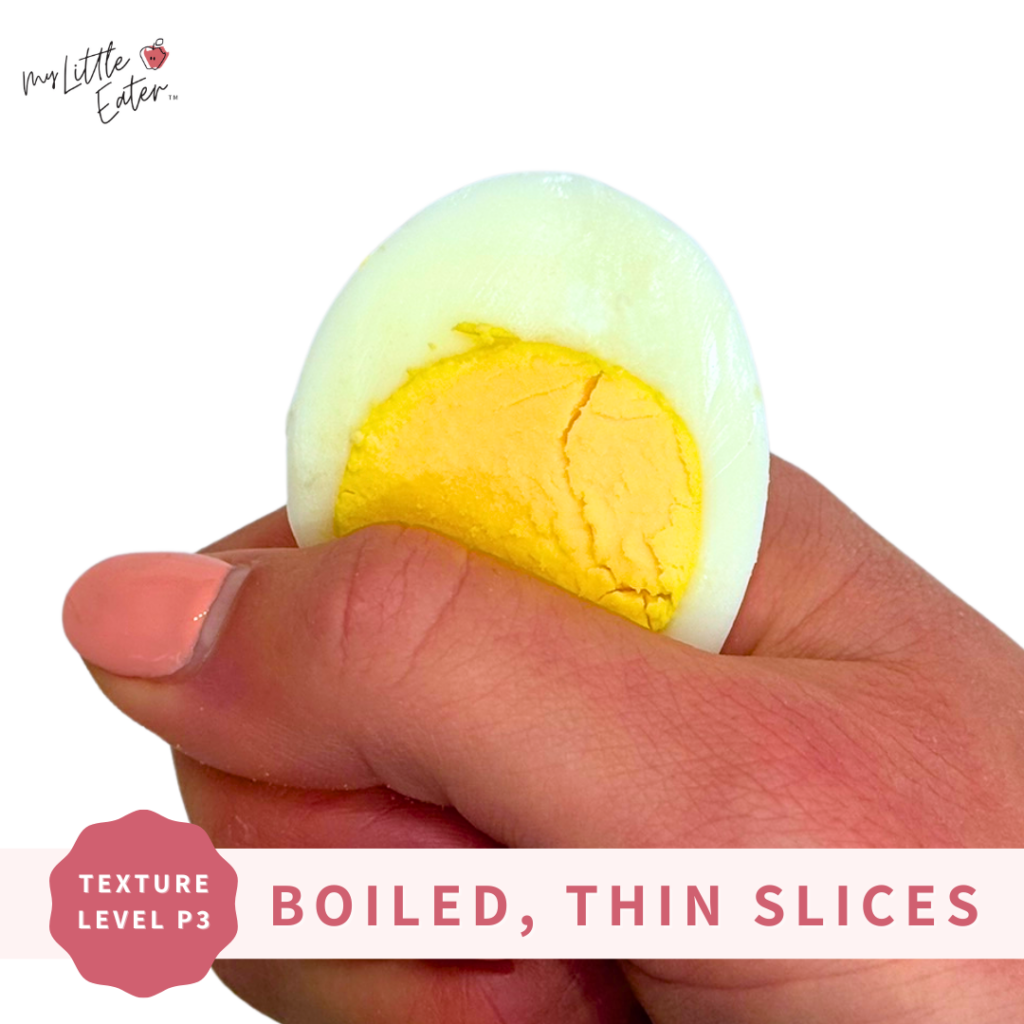
Texture Timeline™ Phase 3
Option 2: Omelet, strips or bite-sized pieces (Palmar or pincer grasp)
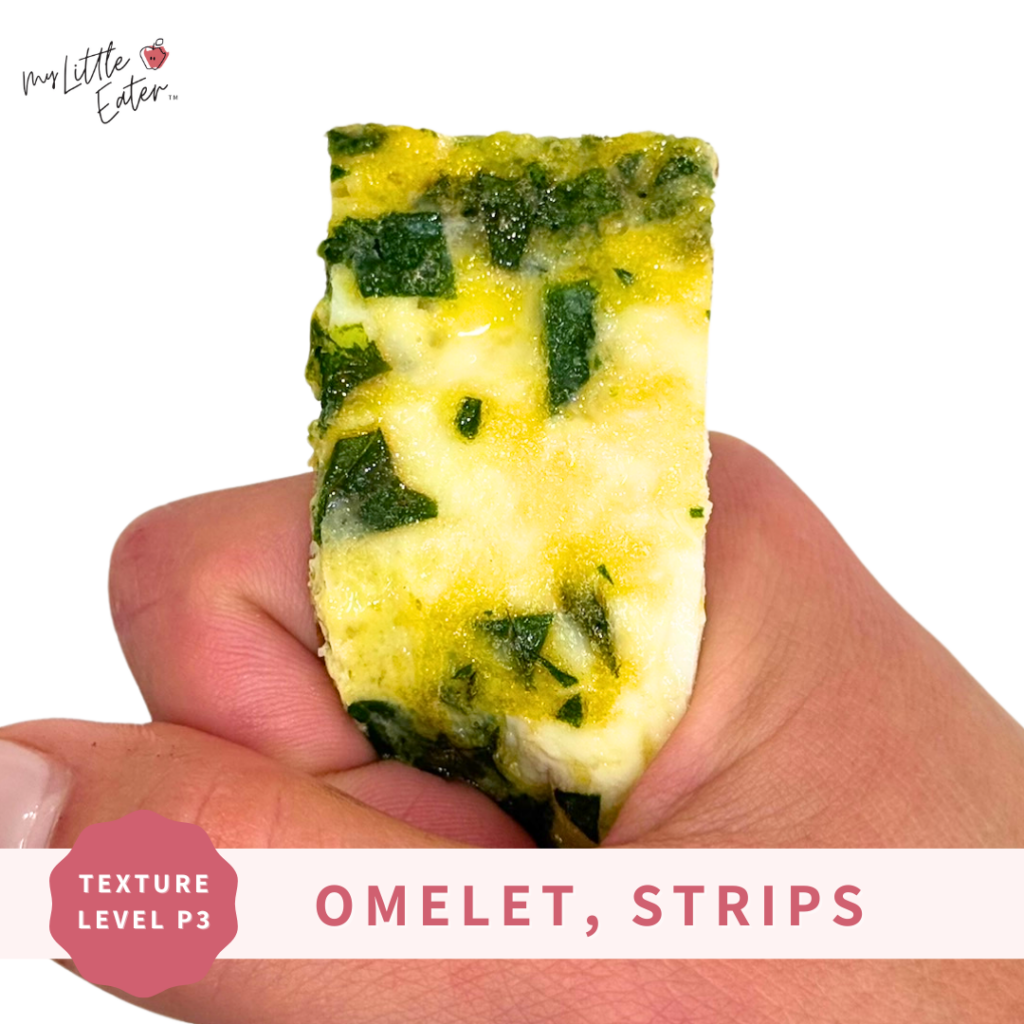
Step 1: Whisk eggs together in a small bowl, then add a splash of milk along with seasonings of your choice (pepper, garlic, onion powder, etc.). Again, be sure that you’ve already ruled dairy out as an allergy before using it with the first egg exposures.
You may also choose to add veggies into your baby’s omelet such as finely chopped spinach or finely chopped, cooked kale.
Step 2: Melt a tablespoon of butter in a skillet over medium heat.
Step 3: Pour the egg mixture into the skillet and reduce heat to medium-low. Cover the skillet and allow the eggs to set (this should take about 2-3 minutes).
Step 4: Flip the omelet and let it cook covered for a few more minutes (about 2-3 minutes should do it).
Step 5: Cut the omelet into strips about 1-2 inches wide and 3 inches long, then serve to your baby for them to pick up and hold using their palmar grasp. OR cut the omelet into bite-sized pieces about ½-1 inch in size, then serve to your baby for them to pick up and hold using their pincer grasp.
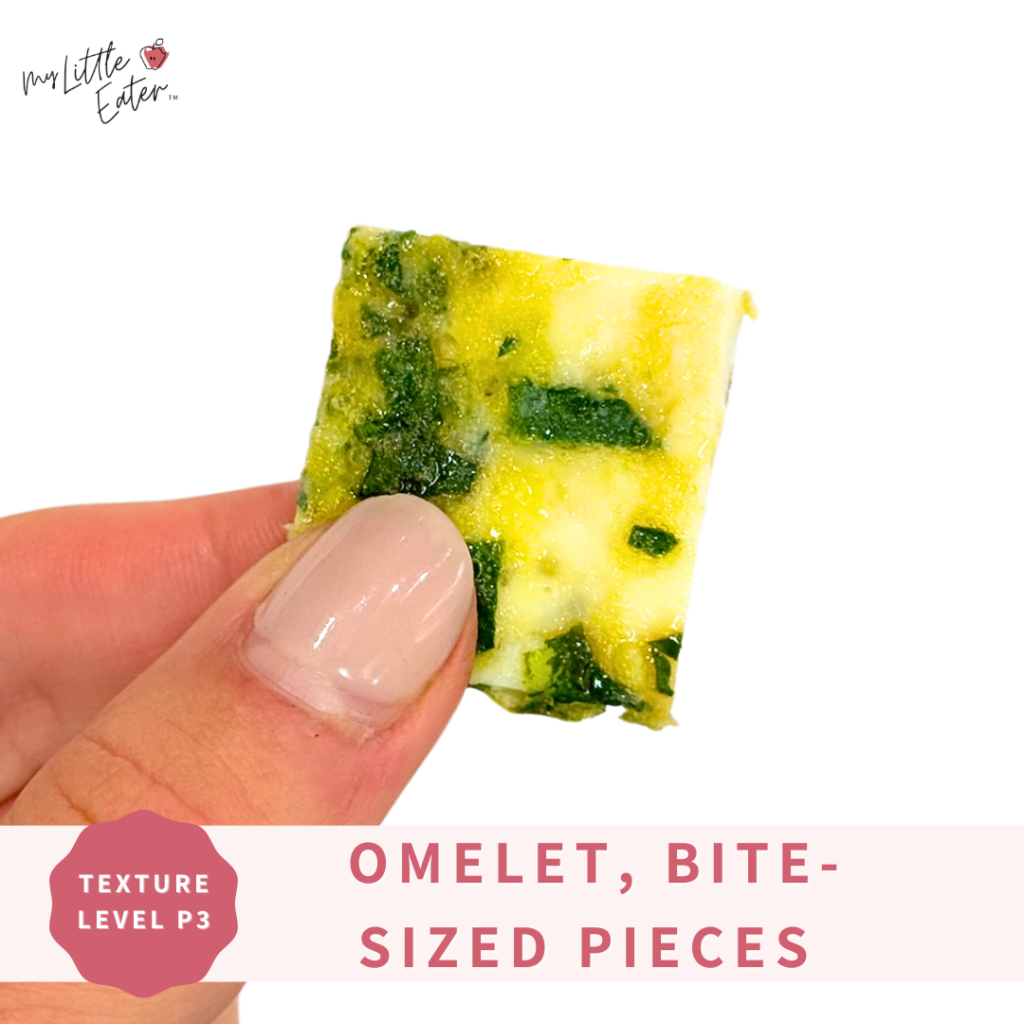
To get instant access to our Texture Timeline™ Food Video Library to learn step-by-step instructions for how to prepare all foods following the phases of our Texture Timeline™, join our Baby Led Feeding Program!
This program is complete with video lessons, printable resources for everything along the way, daily guidance, a 60 Day Baby Led Feeding Meal Plan (with recipes + grocery lists!), and an app to access it all at your fingertips. It’s like having a team of feeding experts in your pocket supporting you every step of the way.
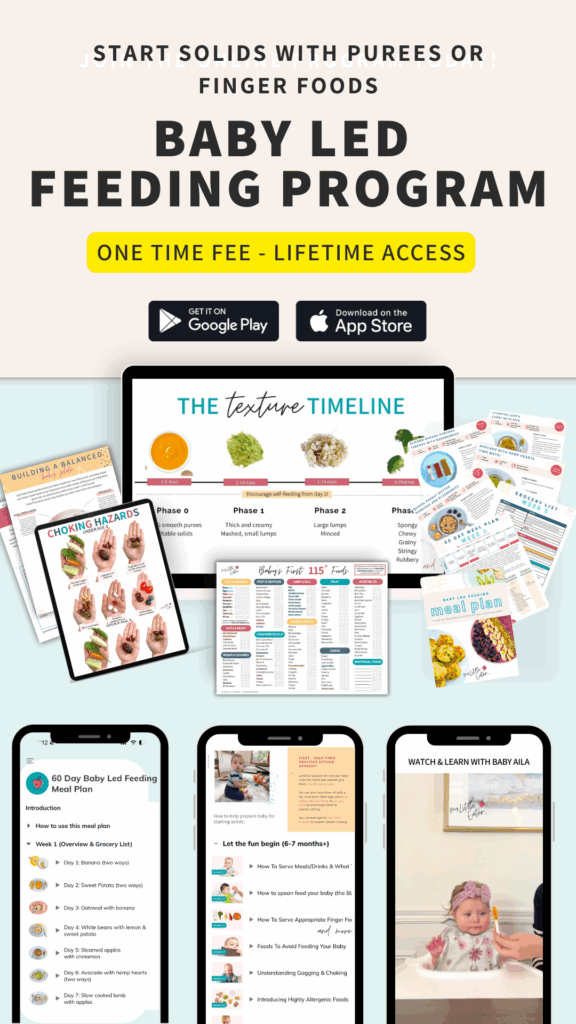
How to create a balanced meal with eggs
A balanced plate for a baby includes the following three components to help meet their needs for proper growth and development:
- High-iron food
- High-calorie food
- Produce (fruit or veg)
Iron and fat are both crucial for proper growth and development as babies grow more quickly during their first year of life compared to any other time (6).
Produce contains many important vitamins and minerals essential for your baby’s growth (7). Many fruits and veggies also contain Vitamin C, which helps to increase the absorption of iron from the meal (8).
Offering a variety of fruits and vegetables is also very important as it can influence your baby’s taste and food preferences. This helps your baby to accept a wide variety of foods both in babyhood and later on in toddlerhood when picky eating can emerge (9,10,11).
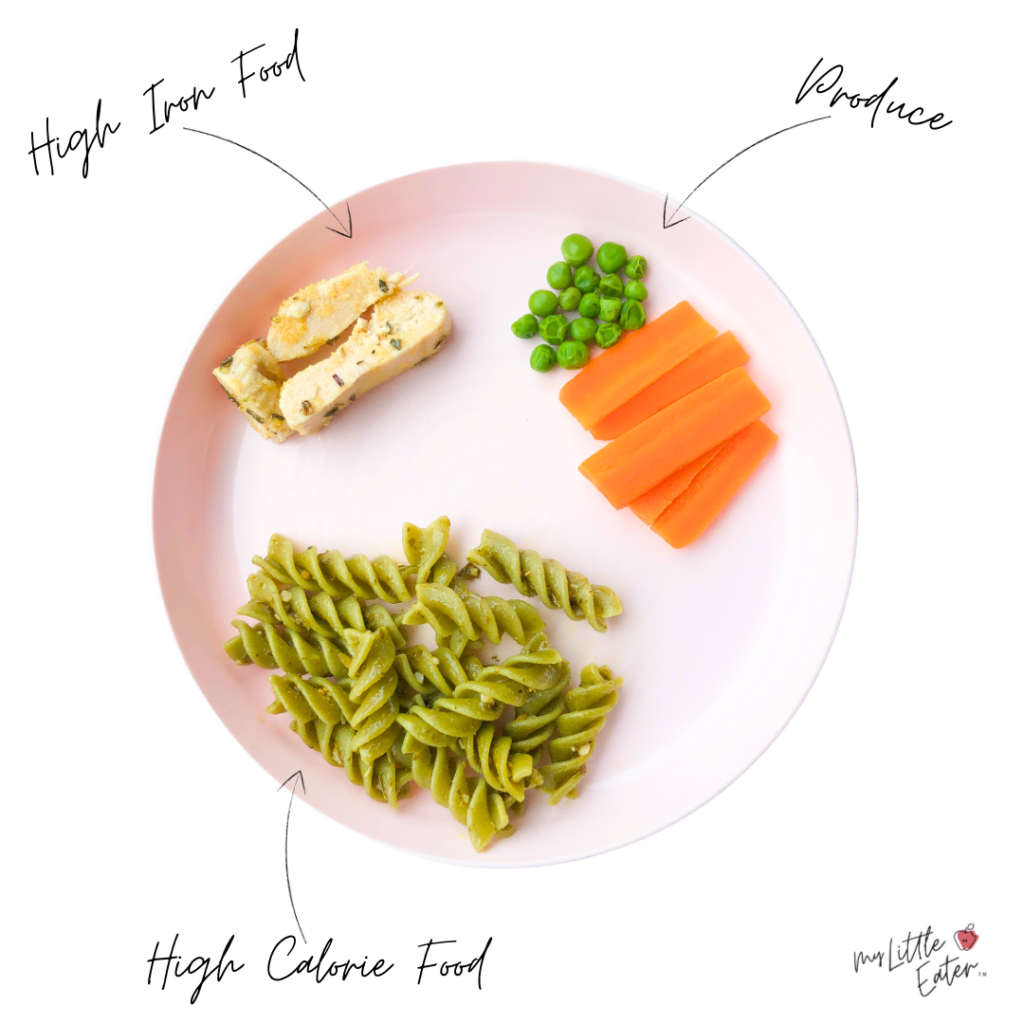
Eggs are a good source of both iron and healthy fat (meaning it’s a calorie-dense food). Therefore, eggs meet two of the above three categories, making them an excellent choice to add to your baby’s meal.
To make a balanced plate, we want to add produce alongside the egg to meet all three categories.
Here are some different fruits and veggies you can offer alongside eggs to create a balanced plate for your baby:
- Ginger stewed pears
- Cinnamon stewed apples
- Quartered berries or grapes
- Oranges
- Kiwi
- Mango
- Lemon wedge
- Bell peppers
- Steamed cauliflower
- Steamed broccoli
If you make a baby omelet, you can also try to change up the veggies included in the omelet. Try adding cooked pieces of bell pepper or onion, finely shredded carrots or zucchini, or even some chopped green onions for variety!
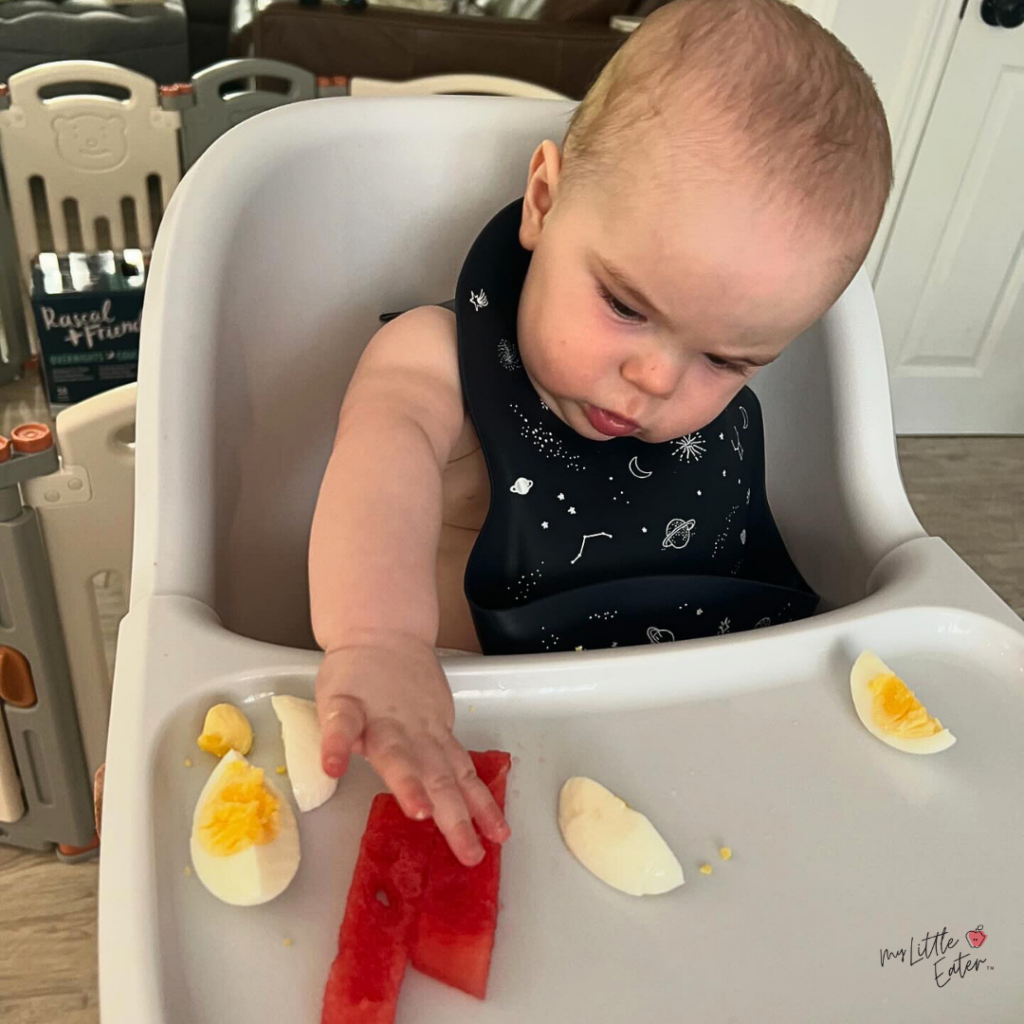
Check out our Texture Timeline food library from our Baby Led Feeding Program for instructions on how to prepare and serve many of these foods safely for your baby!
Keep in mind…
Eggs are very nutritious, which makes them an amazing snack, lunch, or dinner – they aren’t just for breakfast! Besides, “breakfast for dinner” is one of our favorite meals to make when we’re just not feeling like cooking much.
Eggs are also so easy to prep ahead (boil) and keep in the fridge for upwards of 5 days. You can then easily grab these to use as a snack or meal for your baby or toddler throughout the week. These are perfect for busy days so you can get something together fast while keeping your feeding schedule intact and continuing to offer nutritious options.

Eggs are also an excellent, portable food that are easy to keep in a cooler when on-the-go, and that don’t require heating up before eating. So let them show up in different meals throughout the day, and keep the variety coming.
Nutritional benefits of eggs
Eggs are a nutritional powerhouse and are a fantastic food for babies that provide so many benefits! A study looking at the effect of regular egg consumption for babies 6 to 9 months showed a significant improvement in growth and a reduced occurrence of being underweight (12).
One egg provides about 6.5 g of complete protein, which means that it contains all 9 of the essential amino acids that our bodies can’t make on their own (13,14). Eggs are also a good source of iron and vitamin B12, which babies need for healthy growth and development of the brain (13,15,16,17).

Other nutrients found in eggs include (13):
- Fat: Babies and toddlers need lots of healthy fats to sustain their rapid growth. Each egg provides about 5 g, with about 1.7 g of that being monounsaturated fat which is known to support heart health (13,18,19).
- Folate: For the production of healthy red blood cells (20).
- Riboflavin (Vitamin B2): Helps convert food into energy (21).
- Biotin (Vitamin B7): This is important in breaking down fats, carbohydrates, and proteins from food (22, 23).
- Choline: An important nutrient for brain and nervous system development (24).
- Carotenoid pigments lutein and zeaxanthin: These act as antioxidants and support eye health (25,26).
- Vitamin D: Plays a key role in building and maintaining healthy bones, controlling infections, and reducing inflammation (27).
- Vitamin A: Supports the health of the eyes, bones, reproductive system, and immune system (13,28,29).
- Vitamin E: An antioxidant that prevents cell damage, strengthens the immune system, and helps to prevent blood clots from forming in the heart (13,29,30).
Are egg yolks or whites healthier for babies?
In reality, the egg yolk and white contain different nutrient profiles that, when combined and eaten together, create a very nutrient-dense food for your baby.
The egg yolk mainly contains nutrients and fat, while both the yolk and the white contain protein (31). We recommend cooking the whole egg for your baby for maximum health benefit.
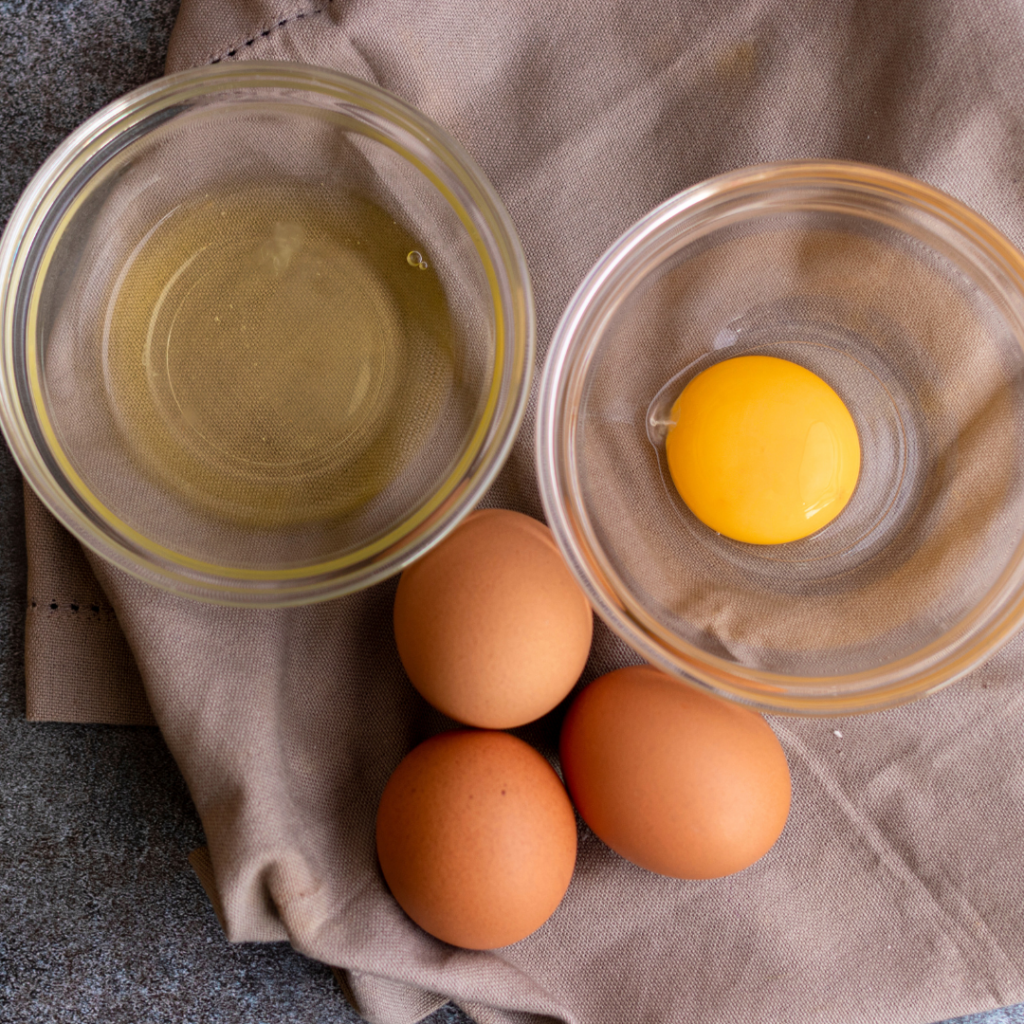
Can babies be allergic to eggs?
Yes, eggs are considered one of the top 10 allergens recognized in Canada and the United States. Egg allergies are one of the most common allergies among babies and young children (32,33).
Like with any top allergen, it’s recommended you introduce your baby to eggs early after starting solids and keep them in the diet often to help minimize the risk of developing an allergy to them (34).

FPIES
Egg is also a common trigger for Food Protein-Induced Enterocolitis Syndrome (FPIES). This is characterized by a sensitivity to the protein in certain foods which causes gastrointestinal symptoms like excessive vomiting and diarrhea (35,36).
Common questions regarding eggs for babies
How many eggs can my baby or toddler eat in a day?
There is no limit!
Babies and toddlers are naturally intuitive eaters, meaning they recognize their hunger and fullness cues.
As parents, we don’t want to restrict their eating as they are in a period of rapid growth and development. If we restrict their food, we’re telling them not to follow their hunger cues or listen to their needs.
Following the golden framework in feeding called the Division of Responsibility, if we as the parents decide to offer eggs in a meal, our child can decide if and how much they eat.

Obviously, we don’t want your child eating mainly eggs and not leaving room for other types of beneficial food in their diet. We want variety in general, but if they want to eat 1,2, 3, or 4 eggs in one sitting – let them go for it! They know what their body needs best.
What if my baby or toddler doesn’t like eggs?
Some babies and toddlers don’t take to eggs right away. While they’re very soft, eggs can be a strange, new texture for them and small pieces of egg can scatter in the mouth and more easily elicit a gag.
To help your baby accept eggs, try the following tips:
- Consistently offer a variety of types of eggs – scrambled, hard-boiled, egg salad, baby omelet, etc. Exposure is SO important to help with acceptance.
- Keep eggs showing up on the menu consistently with no pressure to eat them.
- Model eating eggs for your baby or toddler. When you’re offering eggs to your baby, sit down with them and have eggs on your own plate. While they’re watching, start eating your eggs. This helps teach them to try the food because their instinct will be to imitate what you do.
- Try mixing mashed-scrambled or mashed-boiled eggs into a binder such as yogurt, mayonnaise, or mashed avocado. Offer the mixture on a pre-loaded spoon or let them dig in with their hands. This can help with texture acceptance as well.

In the meantime, if you’re worried about your little one meeting their protein needs if they continuously refuse eggs, it can be helpful to know this…
Toddlers only need 2 servings from the meat & alternative category daily to meet their protein needs, and just one egg counts as two servings!
That means that if your toddler eats one egg, and no other meat, beans, or other high protein food that day – they’ve met their needs! Or, if they eat 2 servings of meat or alternatives that day and barely eat any eggs, they’ve still met their needs!
Don’t worry and think “My toddler only ate ½ an egg…that’s not a meal!” or “They only took two bites…what a failed meal”. Remember – eggs are so nutrient-dense, and kids are so great at balancing their nutrient needs over time. Enjoy the fact that eggs are probably the easiest way to get much-needed nutrition into them and balance the meal out with other foods, such as produce.
Do I have to try different ways of serving eggs to my baby?
When serving eggs (or quite frankly – any food), we tend to fall into the habit of serving it the same one or two ways over and over again. But with all that we know about preventing picky eating, offering as much variety as possible is the best way to prevent strict, no-budge, preferences.
Different ways of preparing eggs offer different texture experiences to your baby. Just because they like eggs scrambled doesn’t mean they’ll take to the rubbery texture of boiled eggs.

Just like with any food that your baby refuses, we want this food to be showing up in the diet more often. So if your baby only likes scrambled eggs and doesn’t like boiled eggs, make sure that boiled eggs are showing up just as much, if not more often than scrambled eggs for consistent exposure to this new texture!
Overall, serve eggs in different ways for variety: boiled, scrambled, baby omelets (with a variety of veggies), egg muffins, an egg salad, diced small, diced large, wedges, etc.
Consistently offering a variety of all foods and textures is key in preventing picky eating later on!
Different types of eggs for babies
There are so many options available at the grocery store now for eggs, it can be hard to understand the benefits of them and know which are best for your family. Let’s break down what’s available and what we recommend to make this a bit easier for you!
My Little Eater
Recommendation
Recommendation
No matter what type of egg you decide to buy from the types below, most have similar nutrient profiles with little variation.
The only major exceptions are the vitamin and omega-3 fortified eggs (which you may want to consider based on your family’s diet). There may also be some small nutritional benefits to free-range and pasture-raised eggs, but the biggest benefit is to animal welfare.
That said, know that these “specialty” egg varieties are not necessary as all eggs are nutritious for your baby or toddler. If you want to buy regular conventional eggs or the eggs that are on sale… go for it!
Ultimately, choosing which one is best for your family is mainly dependent on your commitment to animal welfare standards, what fits within your budget, and what’s available in your area.
Conventional eggs
Conventional caged eggs are the run-of-the-mill eggs you find in the grocery store. They’re the least expensive of all eggs.
The hens that lay these eggs have been raised in small cages in very tight living quarters (37). Even though these conditions are regularly inspected, meaning the cages are kept clean and the hens have unlimited access to clean water and food, Canada is phasing out this type of housing by 2036 in order to improve animal welfare (38).
Canada is moving to enriched colony or cage-free housing (explained below) instead so that the hens can live a less stressful life and can exhibit more natural behavior (38).
Brown eggs
There is no difference in quality, taste, or nutritional value between brown and white eggs (39). The color of an egg is based on the breed of the hen (39).
However, you might notice that eggs with a brown shell are more expensive than eggs with a white shell. This is because eggs with a brown shell are laid by a larger breed of hen that requires more food, making them more expensive (40).
Enriched housing or enriched colony
These hens are offered slightly more space in cages per bird, and cages are equipped with things like nest boxes, perches, and scratch pads so that the hens can express more of their natural behavior (41).
The main difference lies in the housing conditions for these hens. There is no nutritional difference between this type of egg and conventional eggs.
Cage-free or free-run
Cage-free and free-run eggs mean that the hens that laid the eggs weren’t confined to cages and lived in an open indoor space (42). Some of these barns may be equipped with multi-tiered aviaries with perches, food, and water at different heights throughout the barn (43).
They don’t have access to the outdoors, and there are no stipulations around what feed or medications they’re given – which by the way – means that there will be no nutritional difference in these types of eggs compared to conventional ones.
The living conditions vary widely – they may have more space to perform their normal behaviors, or they may be kept in crowded conditions (42).
Free-range
These eggs come from hens that roam the barn floor much like free-run eggs, but in addition, they can go outdoors (weather permitting) for a minimum of six hours per day (43,44). In Canada, this outdoor access is only seasonally available (43,44).
There are no outdoor minimum space requirements, meaning some birds may not receive full-body access to the outdoors (44).
In addition to their feed, hens are able to eat what they find outside and on the barn floor. Again, there are no stipulations around what feed or medications they’re given.
It’s difficult to determine if there are differences in the nutrition of free-range eggs as practices vary widely between farms. However, there is some research showing that free-range eggs may have less cholesterol, less saturated fat, and more vitamins A, E, D, B, beta-carotene, and omega-3s (45,46).
That said, another study found no difference in vitamins A and E in free-range eggs and there seems to be a lot of variation in the nutrient composition of free-range eggs depending on the outdoor diet (47). With hens able to eat whatever they find outside, it’s difficult to pinpoint what may be making a difference in their nutrient composition.
It’s safe to say… more research is needed!
Organic
In Canada, organic eggs must follow standards laid out by the Canadian General Standards Board and are certified by a reputable organic certification board (48). All certified organic eggs are free-range and are fed a certified organic feed (48).
In the US, certified organic eggs are marked by the National Organic Program. US organic eggs come from uncaged hens that have space to roam, are allowed outdoor access, and are fed an organic diet from feed without the use of pesticides or fertilizers (49).
Certified organic labels often require the use of organic feed without antibiotics (50). Some eggs are labeled “no hormones added” – this is nothing but a marketing scheme since no hormones are approved for use in poultry production in both the US and Canada (50).
There is some minor evidence showing that organic eggs may have slightly higher protein and potassium levels, while conventional eggs contain higher magnesium and calcium. (51). This is another case in which more research is needed as results can be contradictory (51).
Essentially, changing the feed changes the nutrition of the eggs as well, but it doesn’t necessarily make organic eggs better, just different in the amount of nutrients they supply the body.
Pasture-raised
Pasture-raised is not a regulated term, however, it typically implies that hens are raised outdoors, based on time of year and location, and are kept in shelters which help to protect them from predators (52).
Shelters are rotated on different areas of the pasture daily so the hens can forage for a larger portion of their food from their natural diet which includes grass, seeds, green plants, insects, and worms (53).
There is some minor evidence showing that pasture-raised eggs may have more Vitamin E and Vitamin A (54). However, other studies showed no significant differences in these vitamins between pasture-raised and conventional eggs (54).
The main benefits seem to be that pasture-raised eggs have more omega-3s and a better overall omega-3 to omega-6 ratio than conventional eggs (54). This matters nutritionally because omega-6 fatty acids are more likely to cause inflammation in your body (54).
However, this research isn’t enough to form any solid conclusions. If you can afford pasture-raised eggs, purchasing them for a potentially slight nutritional advantage, coupled with your desire to support the most humane and natural treatments of the hens – then we say go for it! If not, that’s ok!
Omega-3 fortified
Omega-3 enriched eggs are produced by hens that are fed a special diet rich in flaxseeds (55). Some brands, like Naturegg Omega Plus eggs, even add fish oil, which results in the eggs having a higher Omega-3 and DHA content (55). DHA is the most important kind of omega-3 fats, especially for babies and toddlers who need this to support their rapid brain growth (56,57).
Omega-3 requirements based on age are (58):
- Babies 7-12 months: 500mg/day
- Toddlers 1-3 years: 700mg/day
- Toddlers 4-8 years: 900mg/day
The amount of omega-3 varies between eggs, but conventional eggs may have 30-100mg of omega-3s. Omega-fortified eggs can have as much as 400mg of omega-3s depending on the company.
Many people don’t get enough omega-3s in their diet (59). Adding omega-3 eggs to your or your child’s diet is a great way to get those much-needed DHA fatty acids, especially if you’re unable to get it via 2 servings of fatty fish or a separate supplement.
Make sure to check out our guide on fish for babies and toddlers, where we break down the fish that are high in DHA and how much is required per week to meet your child’s needs.
Vitamin-enhanced
These hens are fed a traditional feed that has been enriched with higher levels of certain nutrients. Vitamin-enriched eggs may have more vitamin E, vitamin D, B vitamins, and omega-3s than regular eggs (60,61).
If you’re able to afford vitamin-enriched eggs for your child for added benefit, go ahead! If not, remember that regular eggs already have a great nutrient profile.
Vegetarian fed
This means that the chickens are fed a no-meat, no-fish, organic, vegetarian-based diet, even though bugs and worms are part of their natural diet (22). This guarantees there are no animal byproducts or questionable ingredients in the hen’s feed (22).
This may be important to someone following a vegetarian diet, however, there is no evidence of a nutritional benefit (22).

Fun fact
Fun fact
The color of an egg yolk can range from pale yellow to deep orange. It does not affect the flavor, nutrient value, or quality of the egg.
The color of the yolk is entirely dependent on what the hen eats! A diet richer in yellow-orange pigmented food like corn will render a darker yolk, whereas wheat-based diets will result in a paler yolk (1).
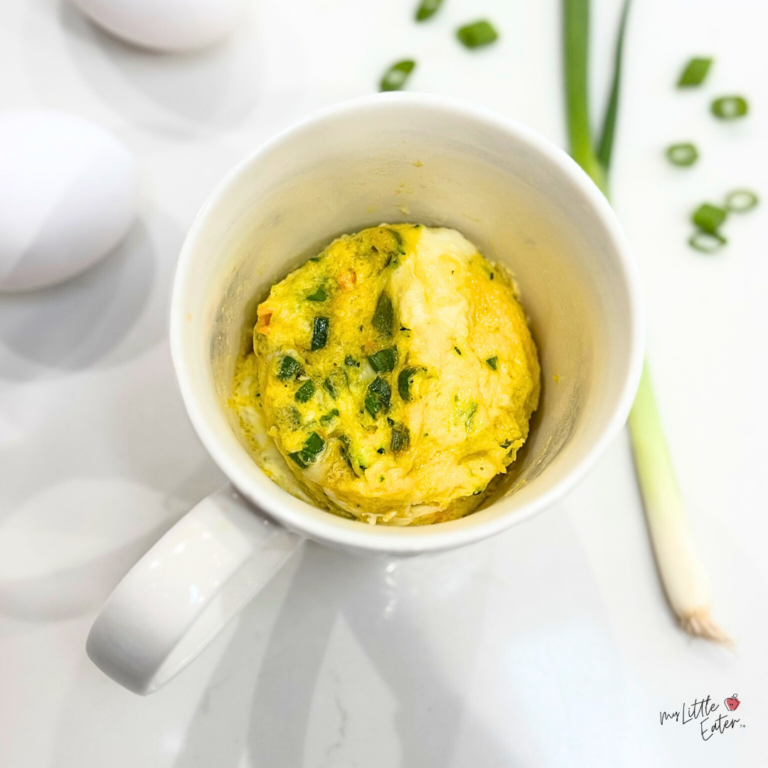
5-Minute Egg-in-a-Mug Recipe
Equipment
- 1 mug
Ingredients
- 2 eggs
- 1 tbsp finely chopped green onion
- 1 tbsp grated zucchini
- 1 tbsp grated cheese
- 1 tbsp milk
Instructions
- Lightly coat a microwave-safe mug with cooking oil.
- Prepare the zucchini by grating 1 tbsp with a cheese grater. Next, squeeze the moisture from the grated zucchini using a muslin cloth or cheesecloth.
- Crack 2 eggs in the mug and add all remaining ingredients to the mug.
- Mix well with a fork.
- Microwave on high for 1 minute or until cooked through.
- Once cooled, you can offer the egg to your baby whole, or cut it into strips or cubes that they can pick up on their own!
Video
Notes
Pin this info for later!
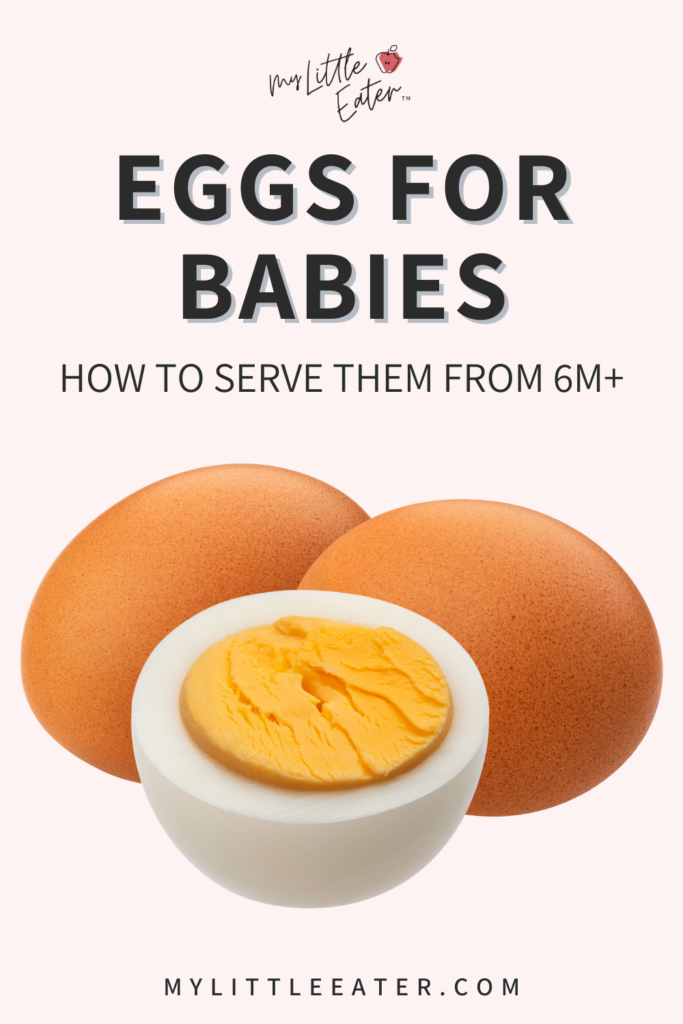
References
- Nys, Y., & Guyot, N. (2011). Egg formation and chemistry. In N. Yves, M. Bain, & F. Van Immerseel (Eds.), Improving the Safety and Quality of Eggs and Egg Products (pp. 83-132). Woodhead Publishing. https://doi.org/10.1533/9780857093912.2.83.
- Government of Canada. Egg Safety. Retrieved from: https://www.canada.ca/en/health-canada/services/meat-poultry-fish-seafood-safety/eggs.html
- Whiley, H., & Ross, K. (2015). Salmonella and eggs: From production to plate. International Journal of Environmental Research and Public Health, 2(3), 2543–2556. doi: 10.3390/ijerph120302543
- Centers for Disease Control and Prevention. Safer food choices for children under 5 years old. Retrieved from: https://www.cdc.gov/food-safety/foods/children-under-5.html
- Egg Info. British Lion eggs. Retrieved from: https://www.egginfo.co.uk/british-lion-eggs
- Holt, K., Wooldridge, N.H., Story, M., & Sofka, D. (2011). Bright Futures Nutrition. American Academy of Pediatrics. https://doi.org/10.1542/9781581106244
- Knai, C., Pomerleau, J., Lock, K., & McKee, M. (2006). Getting children to eat more fruit and vegetables: a systematic review. Preventive medicine, 42(2), 85–95. https://doi.org/10.1016/j.ypmed.2005.11.012
- Cook, J., & Reddy, M. (2001). Effect of ascorbic acid intake on nonheme-iron absorption from a complete diet. The American journal of clinical nutrition. 73. 93-8. DOI: 10.1093/ajcn/73.1.93.
- Spill, M. K., Johns, K., Callahan, E. H., Shapiro, M. J., Wong, Y. P., Benjamin-Neelon, S. E., Birch, L., Black, M. M., Cook, J. T., Faith, M. S., Mennella, J. A., & Casavale, K. O. (2019). Repeated exposure to food and food acceptability in infants and toddlers: a systematic review. The American journal of clinical nutrition, 109(Suppl_7), 978S–989S. https://doi.org/10.1093/ajcn/nqy308
- Mennella J. A. (2014). Ontogeny of taste preferences: basic biology and implications for health. The American journal of clinical nutrition, 99(3), 704S–11S. https://doi.org/10.3945/ajcn.113.067694
- Trabulsi, J. C., & Mennella, J. A. (2012). Diet, sensitive periods in flavour learning, and growth. International review of psychiatry (Abingdon, England), 24(3), 219–230. https://doi.org/10.3109/09540261.2012.675573
- Iannotti, L., Lutter, C., Stewart, C., Riofrío, C., Malo, C., Reinhart, G., et al. (2017). Eggs in Early Complementary Feeding and Child Growth: A Randomized Controlled Trial. Pediatrics, 140(1), e20163459. http://dx.doi.org/10.1542/peds.2016-3459
- U.S. Department of Agriculture. (2019). Egg, whole, cooked, hard-boiled. Retrieved from: https://fdc.nal.usda.gov/food-details/173424/nutrients
- Hoffman, J. R., & Falvo, M. J. (2004). Protein – Which is Best? Journal of sports science & medicine, 3(3), 118–130.
- Iron needs of babies and children. (2007). Paediatrics & child health, 12(4), 333–336. https://doi.org/10.1093/pch/12.4.333
- Venkatramanan, S., Armata, I. E., Strupp, B. J., & Finkelstein, J. L. (2016). Vitamin B-12 and Cognition in Children. Advances in nutrition (Bethesda, Md.), 7(5), 879–888. https://doi.org/10.3945/an.115.012021
- Kumar, N. (2014). Neurologic aspects of cobalamin (B12) deficiency. Handbook of clinical neurology, 120, 915–926. https://doi.org/10.1016/B978-0-7020-4087-0.00060-7
- Myers, M., & Ruxton, C. H. S. (2023). Eggs: Healthy or Risky? A Review of Evidence from High Quality Studies on Hen’s Eggs. Nutrients, 15(12), 2657. https://doi.org/10.3390/nu15122657
- Gillingham, L. G., Harris-Janz, S., & Jones, P. J. (2011). Dietary monounsaturated fatty acids are protective against metabolic syndrome and cardiovascular disease risk factors. Lipids, 46(3), 209–228. https://doi.org/10.1007/s11745-010-3524-y
- Ross, A. C., Caballero, B. H., Cousins, R. J., Tucker, K. L., & Ziegler, T. R. (2012). Modern nutrition in health and disease: Eleventh edition. Wolters Kluwer Health Adis (ESP).
- Marcus, J.B. (2013). Vitamin and Mineral Basics: The ABCs of Healthy Foods and Beverages, Including Phytonutrients and Functional Foods: Healthy Vitamin and Mineral Choices, Roles and Applications in Nutrition Food Science and the Culinary Arts. In J.B. Marcus (Eds.), Culinary Nutrition (pp. 279-331). Academic Press. https://doi.org/10.1016/B978-0-12-391882-6.00007-8.
- The Nutrition Source. Eggs. Retrieved from: https://nutritionsource.hsph.harvard.edu/food-features/eggs/
- The Nutrition Source. Biotin – Vitamin B7. Retrieved from: https://nutritionsource.hsph.harvard.edu/biotin-vitamin-b7/
- Institute of Medicine (US) Standing Committee on the Scientific Evaluation of Dietary Reference Intakes and its Panel on Folate, Other B Vitamins, and Choline. (1998). Dietary Reference Intakes for Thiamin, Riboflavin, Niacin, Vitamin B6, Folate, Vitamin B12, Pantothenic Acid, Biotin, and Choline. National Academies Press (US). Retrieved from: https://pubmed.ncbi.nlm.nih.gov/23193625/
- Goodrow, E. F., Wilson, T. A., Houde, S. C., Vishwanathan, R., Scollin, P. A., Handelman, G., & Nicolosi, R. J. (2006). Consumption of one egg per day increases serum lutein and zeaxanthin concentrations in older adults without altering serum lipid and lipoprotein cholesterol concentrations. The Journal of nutrition, 136(10), 2519–2524. https://doi.org/10.1093/jn/136.10.2519
- Wilson, L. M., Tharmarajah, S., Jia, Y., Semba, R. D., Schaumberg, D. A., & Robinson, K. A. (2021). The Effect of Lutein/Zeaxanthin Intake on Human Macular Pigment Optical Density: A Systematic Review and Meta-Analysis. Advances in nutrition (Bethesda, Md.), 12(6), 2244–2254. https://doi.org/10.1093/advances/nmab071
- The Nutrition Source. Vitamin D. Retrieved from: https://nutritionsource.hsph.harvard.edu/vitamin-d/
- The Nutrition Source. Vitamin A. Retrieved from: https://nutritionsource.hsph.harvard.edu/vitamin-a/
- Réhault-Godbert, S., Guyot, N., & Nys, Y. (2019). The Golden Egg: Nutritional Value, Bioactivities, and Emerging Benefits for Human Health. Nutrients, 11(3), 684. https://doi.org/10.3390/nu11030684
- The Nutrition Source. Vitamin E. Retrieved from: https://nutritionsource.hsph.harvard.edu/vitamin-e/
- Caffarelli, C., Giannetti, A., Rossi, A., & Ricci, G. (2022) Egg Allergy in Children and Weaning Diet. Nutrients 14(8):1540. doi: 10.3390/nu14081540.
- American College of Asthma, Allergy, & Immunology. (2019). Egg. Retrieved from: https://acaai.org/allergies/allergic-conditions/food/egg/
- Praticò, A. D., Mistrello, G., La Rosa, M., Miraglia Del Giudice, M., Marseglia, G., Salpietro, C., & Leonardi, S. (2014). Immunotherapy: a new horizon for egg allergy? Expert Review of Clinical Immunology, 10(5), 677–686. https://doi.org/10.1586/1744666X.2014.901887
- Kakieu Djossi, S., Khedr, A., Neupane, B., Proskuriakova, E., Jada, K., & Mostafa, J. A. (2022). Food Allergy Prevention: Early Versus Late Introduction of Food Allergens in Children. Cureus, 14(1), e21046. https://doi.org/10.7759/cureus.21046
- Nowak-Węgrzyn, A., Jarocka-Cyrta, E., & Moschione Castro, A. (2017). Food Protein-Induced Enterocolitis Syndrome. Journal of investigational allergology & clinical immunology, 27(1), 1–18. https://doi.org/10.18176/jiaci.0135
- American Academy of Allergy, Asthma and Immunology. (2024). Food Protein-Induced Enterocolitis Syndrome (FPIES). Retrieved from: https://www.aaaai.org/tools-for-the-public/conditions-library/allergies/food-protein-induced-enterocolitis-syndrome-fpies
- The Incredible Egg. Egg Production. Retrieved from: https://www.incredibleegg.org/professionals/foodservice/eggs-egg-products/egg-types/
- BCSPCA. Understanding egg labels. Retrieved from: https://spca.bc.ca/news/understanding-egg-labels/
- Eggs. Are white and brown eggs different? Retrieved from: https://eggs.ca/faq/are-white-and-brown-eggs-different/
- Consumer Reports. Why are brown eggs more expensive than white ones? Retrieved from: https://www.consumerreports.org/health/food-shopping/why-are-brown-eggs-more-expensive-than-white-ones-a1141700310/#
- Farmers of Alberta. Enriched hen housing. Retrieved from: https://eggs.ab.ca/healthy-birds/hen-housing/enriched-housing/
- The Humane League. What are cage-free eggs? The difference between cage-free and free range. Retrieved from: https://thehumaneleague.org/article/cage-free
- Eggs. What’s the difference between free run and free range eggs? Retrieved from: https://eggs.ca/faq/whats-the-difference-between-free-run-and-free-range-eggs/
- Certified Humane. “Free Range” and “Pasture Raised” officially defined by HFAC for Certified Humane® label. Retrieved from: https://certifiedhumane.org/free-range-and-pasture-raised-officially-defined-by-hfac-for-certified-humane-label/
- Brower, S., Dorsey, J., Malvetti, K., & Fagan, M. Taste and Nutritional Differences of Non-Factory Farmed vs. Factory Farmed Eggs and Poultry. Retrieved from: https://rucore.libraries.rutgers.edu/rutgers-lib/45132/PDF/1/play/
- English, M. (2021). The chemical composition of free-range and conventionally-farmed eggs available to Canadians in rural Nova Scotia. PeerJ Life & Environment, 9:e11357. doi: 10.7717/peerj.11357
- Anderson, K. E. (2011). Comparison of fatty acid, cholesterol, and vitamin A and E composition in eggs from hens housed in conventional cage and range production facilities. Poultry Science, 90(7), 1600-1608. https://doi.org/10.3382/ps.2010-01289
- Eggs. How are eggs certified organic. Retrieved from: https://eggs.ca/faq/how-are-eggs-certified-organic/
- U.S. Department of Agriculture. Eggstra! Eggstra! Learn All About Them. Retrieved from: https://www.usda.gov/about-usda/news/blog/eggstra-eggstra-learn-all-about-them
- Chicken Farmers of Canada. Understanding organic and other terms. https://www.chicken.ca/chicken-school/understanding-organic-and-other-terms/
- Xia, F., Zhao, Y., Xing, M., Sun, Z., Huang, Y., Feng, J., & Shen, G. (2022). Discriminant Analysis of the Nutritional Components between Organic Eggs and Conventional Eggs: A 1H NMR-Based Metabolomics Study. Molecules, 27(9):3008. doi: 10.3390/molecules27093008.
- J&L Green Farm. Pasture Raised Chicken Eggs Principles: By moving chickens daily to fresh green grass we produce healthy eggs and healthy land! Retrieved from: https://www.jlgreenfarm.com/pastured-eggs
- Delishably. The Difference Between Pastured, Organic, and Free-Range Eggs. Retrieved from: https://delishably.com/dairy/How-to-buy-the-healthiest-eggs
- Sergin, S., Jambunathan, V., Garg, E., Rowntree, J.E., & Fenton, J.I. (2022). Fatty Acid and Antioxidant Profile of Eggs from Pasture-Raised Hens Fed a Corn- and Soy-Free Diet and Supplemented with Grass-Fed Beef Suet and Liver. Foods, 11(21):3404. doi: 10.3390/foods11213404.
- Fraeye, I., Bruneel, C., Lemahieu, C., Buyse, J., Muylaert, K., & Foubert, I. (2012). Dietary enrichment of eggs with omega-3 fatty acids: A review. Food Research International, 48(2, 961-969. https://doi.org/10.1016/j.foodres.2012.03.014.
- Bernardi, J. R., Escobar, S. R., Ferreira, C.F., & Pelufo, S. P. (2012). Fetal and neonatal levels of omega-3: effects on neurodevelopment, nutrition, and growth. ScientificWorldJournal, 2012:202473. doi: 10.1100/2012/202473.
- Kuratko, C. N., Barrett, E. C., Edward, B., & Salem, N. (2013). The Relationship of Docosahexaenoic Acid (DHA) with Learning and Behavior in Healthy Children: A Review. Nutrients, 5(7), 2777-2810; https://doi.org/10.3390/nu5072777
- National Institute of Health. Omega-3 fatty acids. Retrieved from: https://ods.od.nih.gov/factsheets/Omega3FattyAcids-HealthProfessional/
- American Health Association. Are you getting enough omega-3 fatty acids? Retrieved from: https://www.heart.org/en/news/2023/06/30/are-you-getting-enough-omega-3-fatty-acids
- Egg. FAQ. https://eggs.ca/faq/what-are-the-different-kinds-of-eggs-at-the-grocery-store/
- Manitoba Egg Farmers. Types of eggs. Retrieved from: https://www.eggs.mb.ca/about-eggs/types-of-eggs

Jillian Smith, RD
Registered Dietitian at My Little Eater Inc., and dog-mom to River. Jillian works behind the scenes answering nutrition questions and supporting parents of babies and toddlers to feed their little ones with confidence.
Click below to book a counselling session with Jill today!

Jillian Smith, RD
Registered Dietitian at My Little Eater Inc., and dog-mom to River. Jillian works behind the scenes answering nutrition questions and supporting parents of babies and toddlers to feed their little ones with confidence.
Click below to book a counselling session with Jill today!

Bianca Gruenewald, RD
Bianca is a Registered Dietitian and works in a client support role at My Little Eater Inc. She's a proud auntie to her three year old niece and four year old nephew!

Bianca Gruenewald, RD
Bianca is a Registered Dietitian and works in a client support role at My Little Eater Inc. She's a proud auntie to her three year old niece and four year old nephew!

Mallory Roberts, SLP
Mallory is a Speech-Language Pathologist, Infant Feeding Specialist, and Craniosacral Therapist. She's also a busy mom of four little ones!

Mallory Roberts, SLP
Mallory is a Speech-Language Pathologist, Infant Feeding Specialist, and Craniosacral Therapist. She's also a busy mom of four little ones!
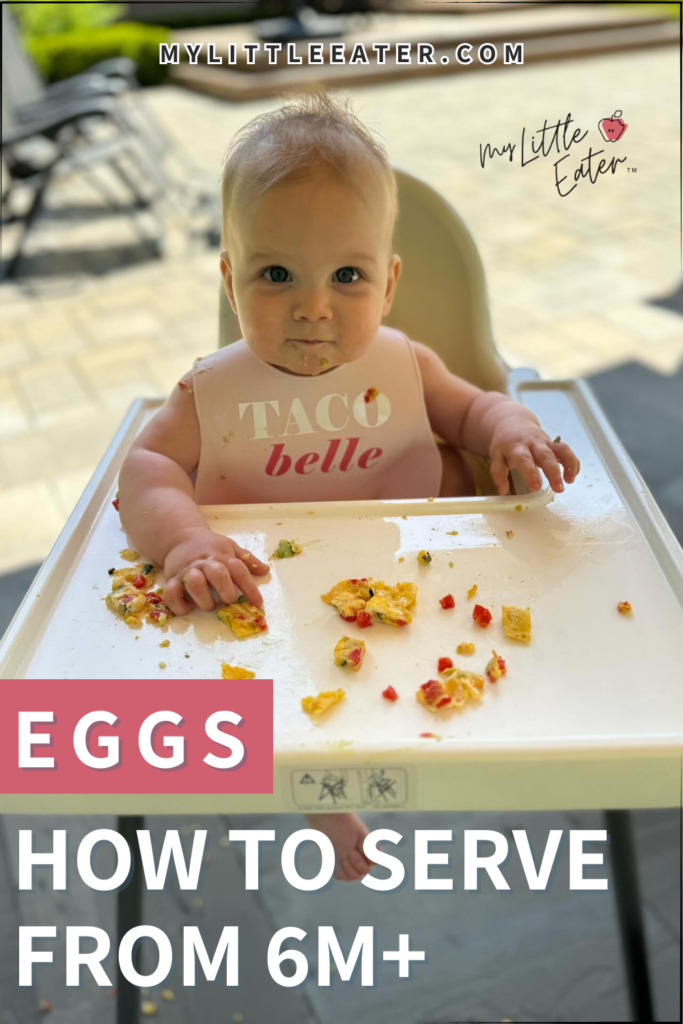

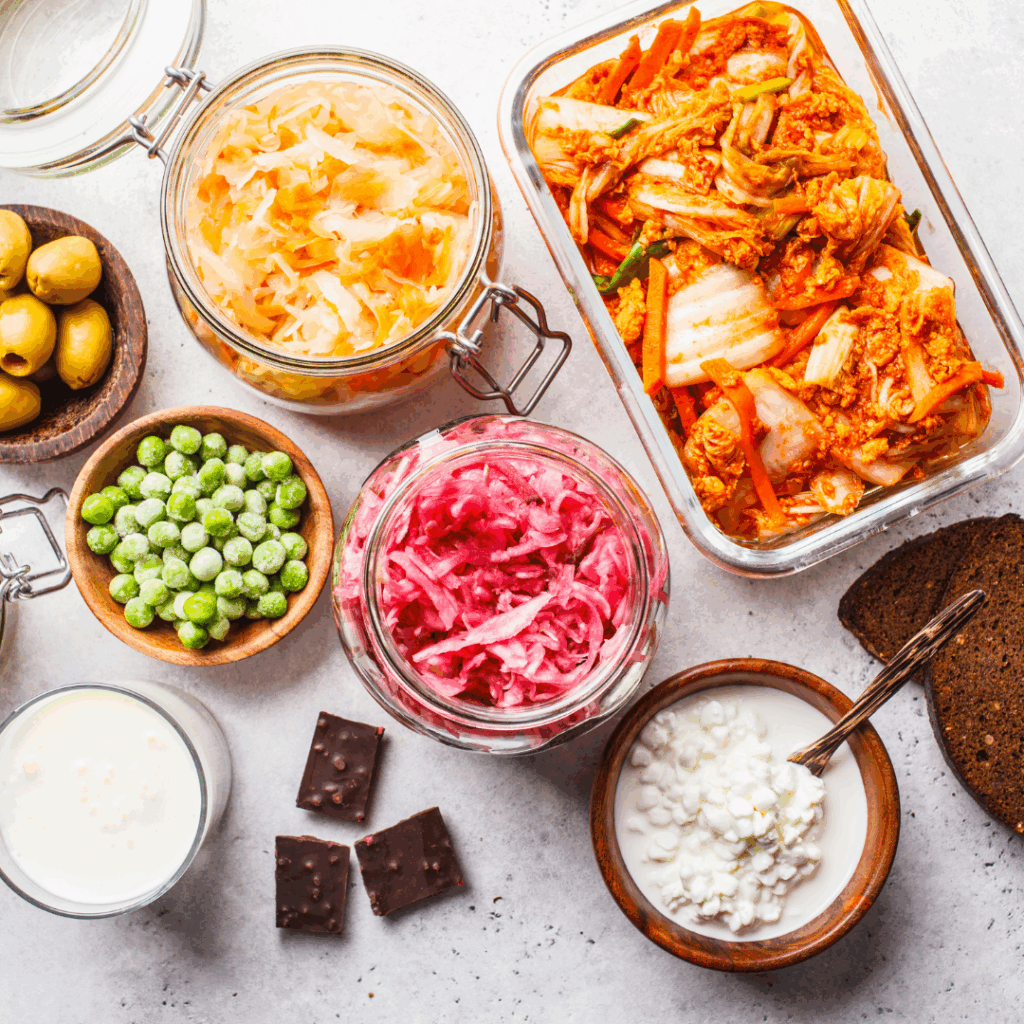
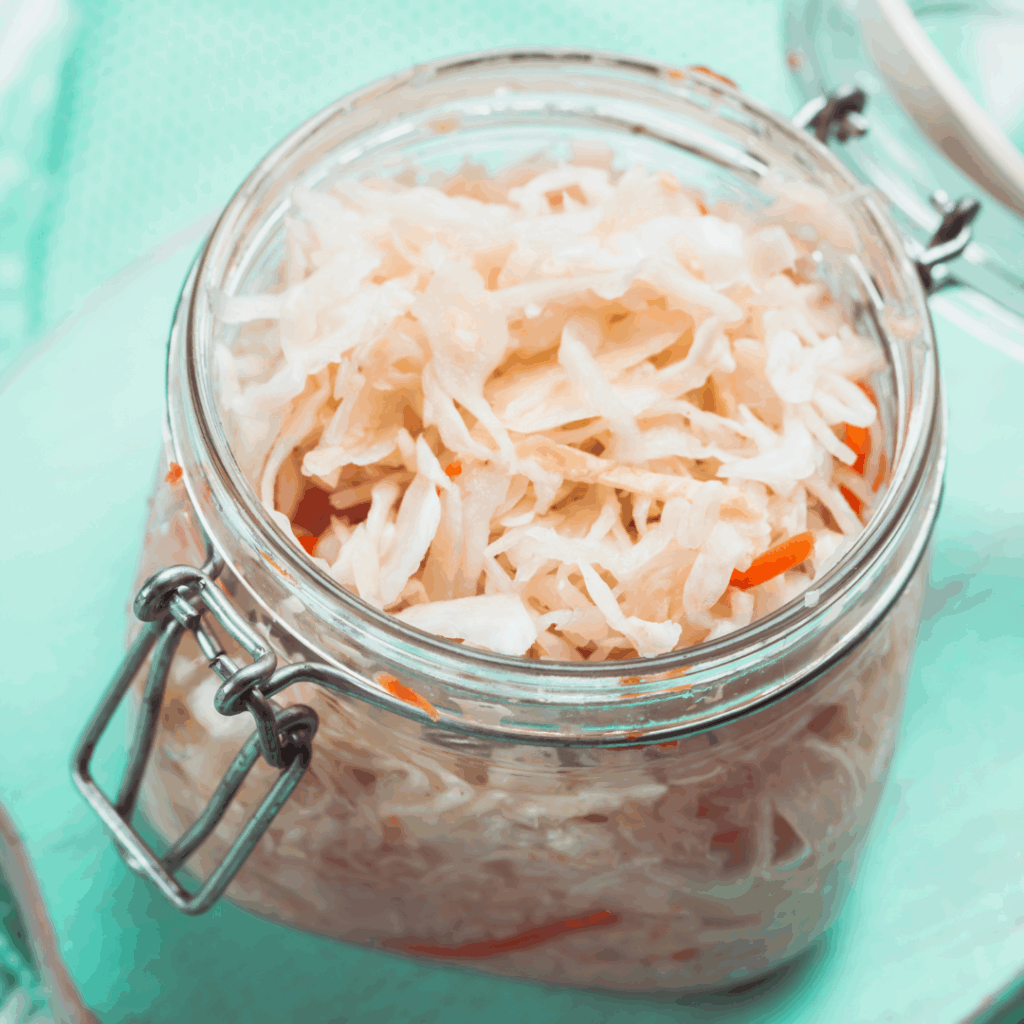






8 Comments
Thank you for this comprehensive guide on introducing eggs to my little one! I appreciated the tips on preparation and serving ideas. It’s been helpful to understand the best ways to make eggs safe and enjoyable for babies and toddlers. Can’t wait to try out some of these recipes!
We’re so glad you enjoyed the blog and found it helpful!
This is such a helpful guide! I’ve been unsure about introducing eggs to my toddler’s diet, but your tips on preparation and storage make it seem much easier. I love the recipe suggestions too! Thank you for sharing!
We’re so glad you found our blog helpful!!
Great post! I appreciate the detailed information on introducing eggs to my baby’s diet. The tips on cooking methods and potential allergies are super helpful. I’ll definitely choose scrambled eggs for my little one’s first taste. Thanks for sharing!
We’re so glad you found our blog helpful!
Great article! I appreciate the detailed information on introducing eggs to my baby’s diet. The tips on cooking methods and allergy considerations are really helpful. Looking forward to trying these out with my little one!
We’re so glad you found our blog helpful! Happy feeding!